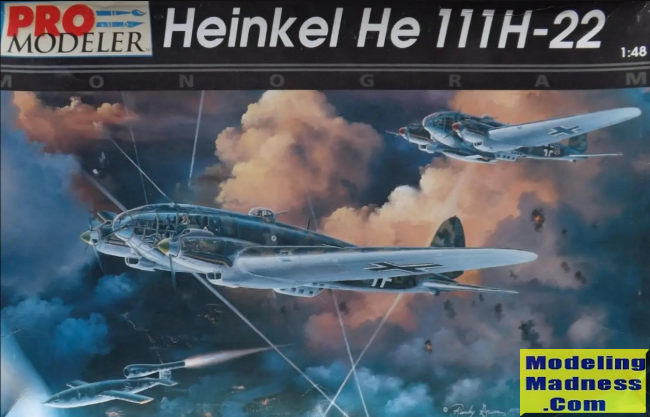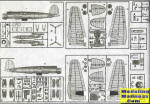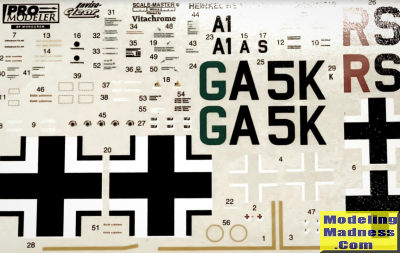
| KIT #: | 5926 |
| PRICE: | $35.00 |
| DECALS: | Two options |
| REVIEWER: | Spiros Pendedekas |
| NOTES: |

| HISTORY |
The He 111 was essentially a bomber designed by Siegfried and Walter Günter at
Heinkel Flugzeugwerke in 1934. Through development, it was described as a "wolf
in sheep's clothing", since, due to the known restrictions placed on Germany
after the First World War prohibiting bombers, it was presented as a civil
airliner, although from conception the design was intended to provide the
nascent Luftwaffe with a heavy bomber.
The type evolved through constant upgrades to serve in a variety of roles till
the end of the war, even though it had become obsolete well before, being kept
in service only because there was no successor, due to the failure of the “B
Bomber” second-generation high-speed bomber project. The H-22 variant, emerged
from re-designated and modified H-6, H-16, and H-21 sub types, was used to air
launch V-1 flying-bombs via a dedicated pylon.
| THE KIT |
 Monogram
came with their 1/48 He 111H family in 1994, reboxing and occasionally updating
them with new parts till 2010. Particularly considering their 1994 origins, the
series are by all means good, solid kits with nice engraved panel lines,
sufficient overall detailing and mainly accurate (I have read that, being sort
of a collage of subtypes, the kits are not 100% accurate and I will leave the
rest to the Experten). Apart from Revell-Monogram (and Pro Modeler) these kits
have even been twice reboxed by Hasegawa and, as a note, the kit must not be
confused with the 2019 H-6 edition of the “New Revell” era, which is a rebox of
the ICM offering.
Monogram
came with their 1/48 He 111H family in 1994, reboxing and occasionally updating
them with new parts till 2010. Particularly considering their 1994 origins, the
series are by all means good, solid kits with nice engraved panel lines,
sufficient overall detailing and mainly accurate (I have read that, being sort
of a collage of subtypes, the kits are not 100% accurate and I will leave the
rest to the Experten). Apart from Revell-Monogram (and Pro Modeler) these kits
have even been twice reboxed by Hasegawa and, as a note, the kit must not be
confused with the 2019 H-6 edition of the “New Revell” era, which is a rebox of
the ICM offering.
The specific kit is the 1995 Pro Modeler version that contained some extra
parts, mainly for the V-1 flying bomb and its pylon (but also some nice figures,
among others). A nice Pro Modeler poster and ditto badge was also included in
the big, top opening and relatively flimsy box, which carried a very attractive
box art of 3./KG 3 5K+RS machine having just released its V-1 over a most
hostile environment, presumably a big English city.
Upon opening the box, I was greeted with 112 medium gray styrene parts arranged
in four big and two small (for a total of six) sprues. General shapes of parts
look correct, panel lines are nicely engraved and molding is very good with
minimal, if any, flash. Detail at key areas (cockpit, gondola, landing gear,
aerodynamic surfaces and so on) is certainly sufficient. The V-1 also looks
quite accurate and the crew members provided look equally good.Transparencies,
an absolute key element especially for this glazed nose, are nicely molded and
crystal clear.
Instructions are typical Pro Modeler, meaning excellent, coming to the form of a
22-page b/w booklet, containing a short history of the type, a color chart, with
the construction spread in 15 main steps, of which, apart from the de rigeur
drawings, a hefty amount of precise and detailed text is included in the form of
numbered “sub steps” which the modeler has to follow. Color callouts are given
where applicable, together with various “modeling tips” (like, say, fitting the
wheels at earlier or later stages, according to your style, and how to deal with
each situation). Typically (and wonderfully) for Monogram, all parts names are
mentioned in the instructions, meaning you know the exact description of the
part you are dealing with. The provision of a plethora of Bert Kinzey’s “Detail
& Scale” b/w helpful pics for many areas is the icing of the cake. Really,
instructions could not get better!
 Two schemes
are provided, for a 3./KG 3 5K+RS machine and a Stab./KG 53 Legion Condor A1+GA
example. Both feature the classic RLM70/71 splinter topsides with black gray
undersides (the latter paint typically having an uneven appearance due to its
field application with brushes or even brooms. The Legion Condor aforementioned
machine featured RLM76 blotches on the topside camo. Decals are beautifully
printed by Scalemaster and, though looking in good condition, nice and shiny,
one should bear in mind that they were printed in 1995 and their behavior might
be justifiably compromised when used after almost 30 years!
Two schemes
are provided, for a 3./KG 3 5K+RS machine and a Stab./KG 53 Legion Condor A1+GA
example. Both feature the classic RLM70/71 splinter topsides with black gray
undersides (the latter paint typically having an uneven appearance due to its
field application with brushes or even brooms. The Legion Condor aforementioned
machine featured RLM76 blotches on the topside camo. Decals are beautifully
printed by Scalemaster and, though looking in good condition, nice and shiny,
one should bear in mind that they were printed in 1995 and their behavior might
be justifiably compromised when used after almost 30 years!
Instructions start by having you assemble and paint the figures provided (if you
plan to use them), then assemble the cockpit and top turret. The fuselage halves
are then prepared by attaching the side, ventral and gondola transparencies and
the very nice front and rear bulkheads which feature spars to strengthen the
wing to fuselage joints. The fuselage halves are then joined, trapping the top
turret and the rear wheel between them (but not the cockpit, which is to be
attached from the front opening later on).
The tail assembly and attachment is next, followed by the main wings assembly.
Since the gear doors are one piece with the sidewalls, once attached during this
relatively early stage, care should be taken in order not to bend or knock the
door part off during construction. Main gear, including the weighted wheels, is
then to be fully assembled and attached, but, personally, I would leave it off
and attach everything after painting. The engines are next assembled and
attached, with the completed wings glued to the fuselage.
Next step is to finalize the gondola, followed by cockpit attachment to the
front. Then you are instructed to assemble the V-1 bomb and attach it
underneath, onto its dedicated pylon, followed by the front glazing preparation
and attachment. The props are then assembled and press-fitted into place (I
liked a lot the ingenious press-fit “mechanism” , followed by the usual final
bits (antenna mast, pitot and landing light cover), ending a build which, though
certainly not uncomplex, does not seem too complicated, especially for a twin
engine bomber.
| CONCLUSIONS |
Though superseded by the better ICM He 111 family of kits (which appeared in 2017 and the fact that Revell reboxed their H-6 version in 2019 says a lot…), this seems to be nevertheless a very good kit of the iconic bomber and still (as of 2023) the sole option for a reasonably accurate out of the box H-22 V-1 carrying variant. Molding is great, general shapes of parts look correct, panel lines are nicely engraved, details offered are certainly sufficient at all areas, transparencies are nice and clear, instructions are second to none and decals are well printed (I would consider going for a fresh aftermarket set, though).
Out of the box a decent rendition of the type can emerge and the build itself,
though definitely not to be tackled by a beginner, looks not that complicated
(for a twin engine bomber).
The kit, together with
its more recent reboxings, can yet be found nowadays at prices (if properly
researched) notably lower than the ICM offerings and can still hold its own,
especially as a cheaper alternative.
Definitely a kit worth tackling.
Happy Modeling!
Spiros Pendedekas
November 2023 Copyright ModelingMadness.com. All rights reserved. No
reproduction in part or in whole without express permission. If you would like your product reviewed fairly and fairly quickly, please
contact
the editor or see other details in the
Note to
Contributors.